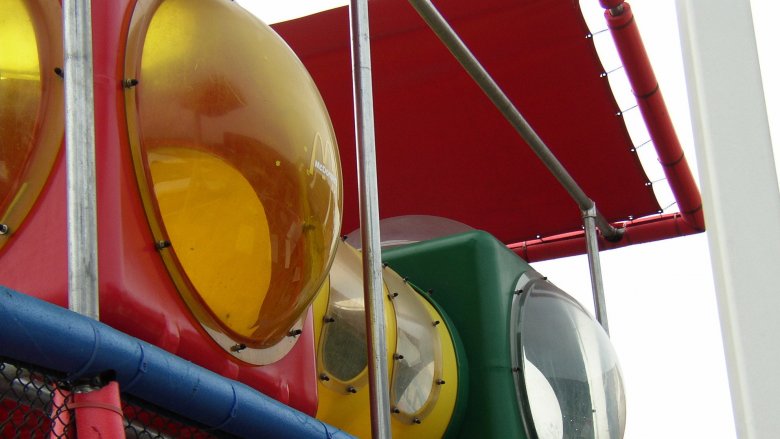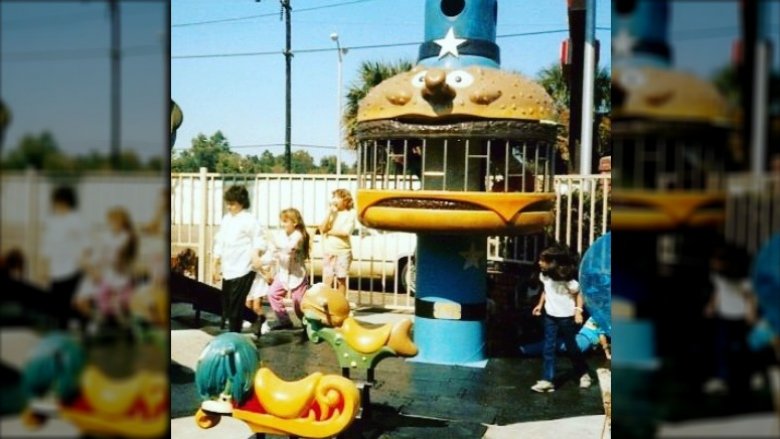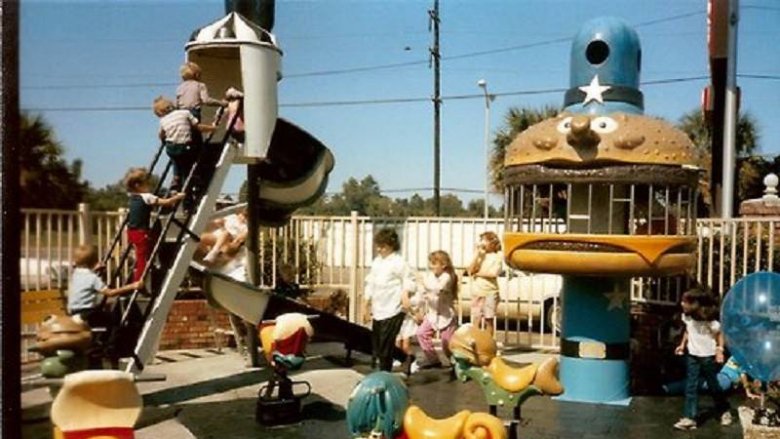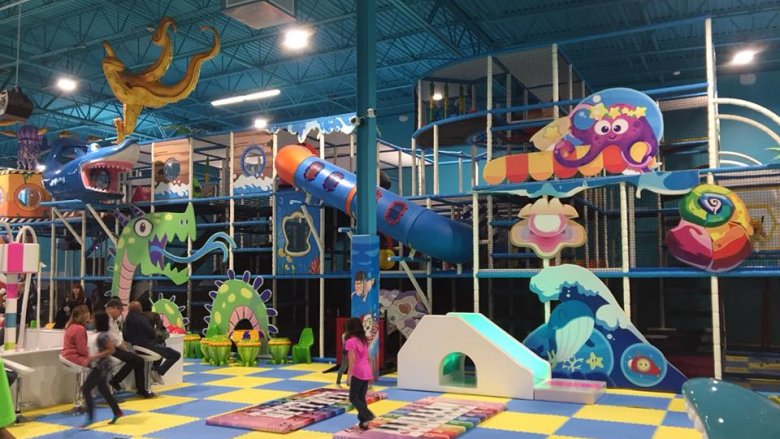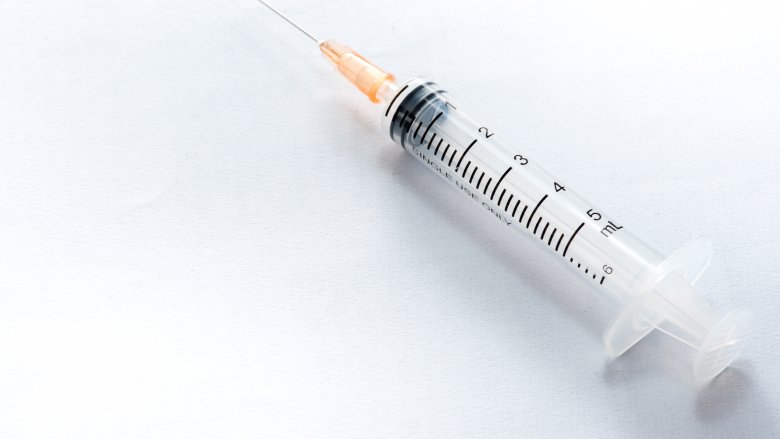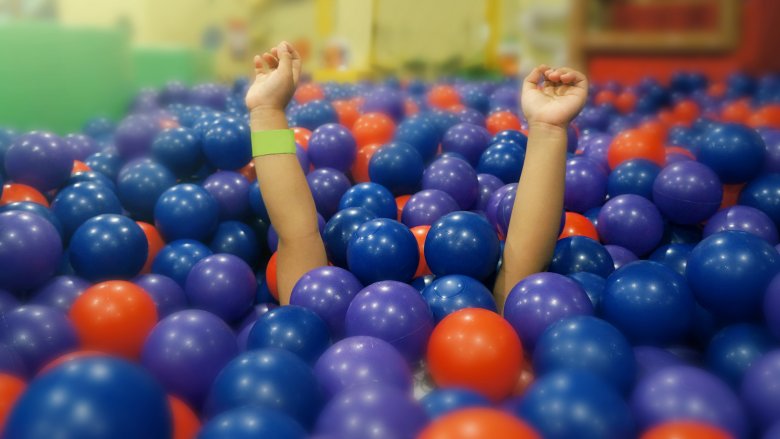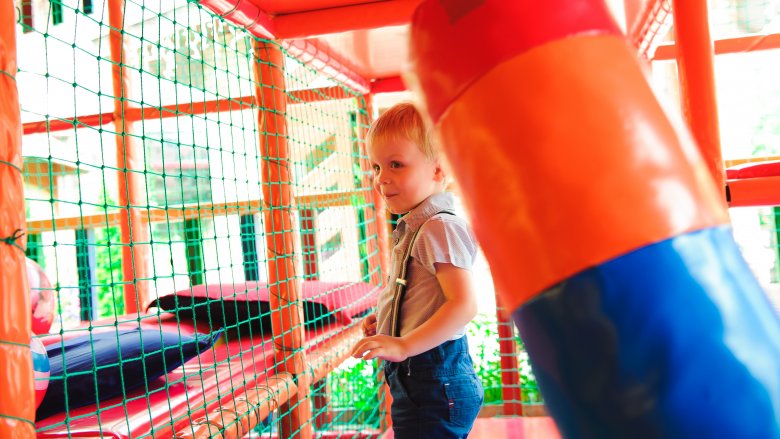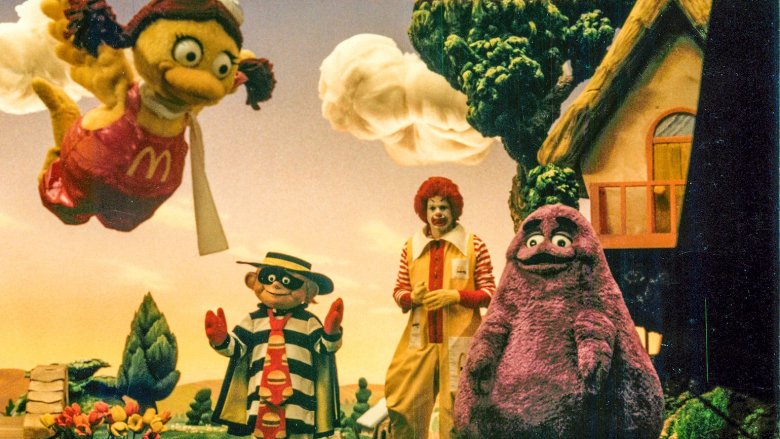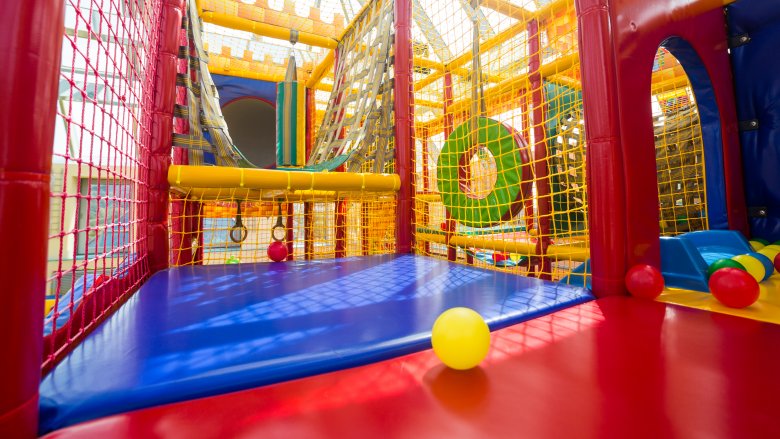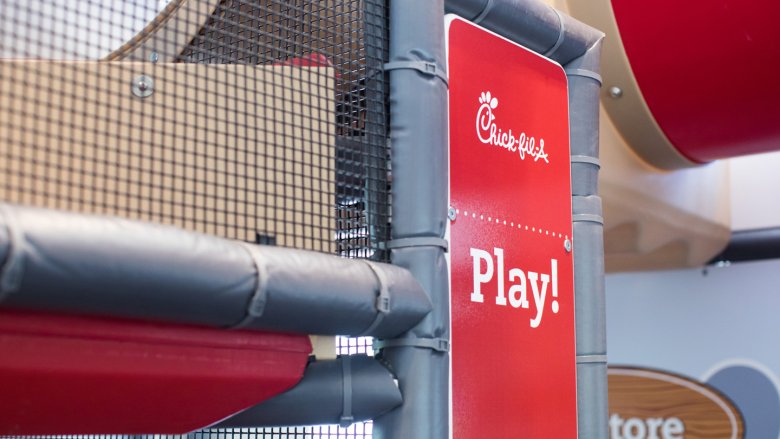The Untold Truth Of Fast Food Playgrounds
Once upon a time, way back in the '90s, the iPad hadn't been invented yet, Boy Meets World was still on the air, and interior playgrounds at fast food restaurants weren't regarded as foul dens of germs and discarded heroine needles. During this magical age, children frolicked in ball pits and slid down slides in the playscapes of restaurants like McDonald's and Burger King. Meanwhile, their parents chatted nearby, knowing their kids were fenced in and playing someplace "safe."
We've come along way from the '90s, the fast food playground heyday when thousands of indoor playscapes could be found in restaurants throughout the nation. Today, fast food playgrounds — demonized as dirty and dangerous —are disappearing fast.
What happened to the once beloved fast food playground to make it dwindle so much over just a couple decades? And what else about them don't you know? To find out, we dived into the dark, sometimes dirty untold truth of fast food playgrounds.
McDonald's started it all in the 1970s
The history of fast food playgrounds begins even before the '90s in a McDonald's in Chula Vista, California. It was in this unassuming, often quiet restaurant where the very first McDonald's PlayLand opened in the early 1970s, as chronicled in this kinda creepy, super '70s McDonald's industrial video. As the video narrator reports, the very first McDonald's PlayLand brought a 34 percent increase in business to it's location before the park was completed, and rose to a 63 percent in volume over subsequent months.
Ronald and his friends were based on characters from McDonaldland, a make-believe world brought to life by advertising agency Needham, Harper & Steers. The characters populated the earliest McDonald's PlayLands in the form of dubious-looking rides, including Captain Crook spiral slides, Hamburglar swings, Mayor McCheese round-a-bouts, Filet-O-Fish springs, and McDonaldLand teeter-totters. The PlayLands were overlooked by Officer Big Mac, who's open mouth served as a ominous climb-in jail.
McDonald's covered up a lot of PlayLand injuries
Remember that Big Mac Climber, McDonaldland's chief of police whose mouth opened into a big, climb-in jail? In 1999, it was revealed that more than 400 children sustained injuries after playing on the Big Mac Climber from the '70s to the '90s.
To make matters worse, McDonald's didn't report the large number of injuries sustained on the Big Mac Climber. Instead, the corporation began slowly phasing out the Climber and other hard metal play structures from PlayLands and replacing them with padded equipment. "The jungle gym was an old piece well on its way to extinction," said McDonald's spokesman Walt Riker told the L.A. Times.
But gradual changes weren't enough to save McDonald's from a massive lawsuit. After McDonald's got rid of the last 190 Climbers in 1997, the US Consumer Product Safety Commission (CPSC) started investigating PlayLands due to lawsuits and consumer complaints. Their investigation discovered more than 400 child injuries, including 10 broken bones, skull fractions, and concussions. In the end, McDonald's ended up paying out $4 million in fees to the federal government —one of the largest the CPSC had ever received.
Unfortunately for McDonald's, this lawsuit came just five years after they agreed to finance a $5 million play area safety campaign due to injuries on their Tug-N-Turn merry-go-rounds. Considering their involvement in that campaign, the new round of unreported injuries didn't look good.
Indoor playgrounds took off in the '90s
The original McDonald's PlayLands set themselves apart from later fast food playgrounds in a few key ways: they were totally outdoors and designed for individual rather than interactive play. Following McDonald's lead, Burger King, too, stuck to outdoor play equipment after first introducing playgrounds in 1985. These original fast food playgrounds were rendered useless in the rain and cold, which was particularly problematic in cold-weather states.
And so, in the '90s, fast food chains began rolling out interior playgrounds (dubbed "PlayPlaces at McDonald's and Kids Club Play Lands at Burger King).These were modern indoor playscapes with tubes, slides, and ball pits, protected by thick padding, fabric, and nets. The more sophisticated among the features were punching bags, swings, and jump-through hoops.
As Tulsa World reported, these indoor fast-food playgrounds came at a time when some cities were cutting public playground funding and school districts were dismantling playgrounds to avoid injuries and lawsuits. Parents celebrated these indoor playscapes as places where kids could run free and interact with other children in a safe, closed off area without wandering off or being "snatched up." So beloved were these new indoor playgrounds, Tulsa World declared, "The fast food playground is here to stay".
McDonald's experimented with a chain of indoor playgrounds that had nothing to do with their restaurants
Ever the innovators, McDonald's briefly experimented with a chain of indoor playgrounds that had nothing to do with burgers. In 1991, the fast-food giant opened a playcenter called Leaps & Bounds in Naperville, a suburb of Chicago.
Pulling inspiration from post-McDonaldland indoor PlayPlace McDonald's designed a two-story playscape with a 350-long tunnel with different sections for children of different ages.
In addition to the play area, Leaps & Bounds included an adult viewing room, private party rooms, and a souvenir stand. There was also a concession stand hawking pizza, turkey dogs, granola bars, fruit, fruit roll-ups (it's the nineties, remember?) but nary a McDonald's menu item in sight. Another key difference between McDonald restaurant playgrounds? McDonald's playground entrance was free, while admission to Leaps & Bounds started at $4.95 per child.
After the Naperville debut, Leaps & Bounds expanded quickly to Chicago and Milwaukee locations before spreading across the nation. By 1994, McDonald's had 45 Leaps & Bounds centers. That year, McDonald's merged with Discovery Zone, a similar indoor child entertainment center. In 1999, Discovery Zone filed for bankruptcy and was partially acquired by Chuck E. Cheese. So, in some small way, Leaps & Bounds lives on amid the crane machine and singing animatronic mouses of Chuck E. Cheese to this day — but you won't see any mention of McDonald's there.
Some of those needle rumors are false
Sensationalized "fake news" has been getting a lot of attention these days, but propaganda and baseless scares have been around since the advent of the written word. Take, for example, the terrifying story of a boy who died of a heroin overdose after being pricked by a syringe left in a McDonald's ball pit. This frightening piece of gossip started circulating the internet cerca 1999.
As the tale went, a woman in Sugarland, Texas took her son to McDonald's to celebrate his third birthday in 1994. After 3-year-old Kevin finished his lunch, he plunged into the ball pit, where he was allegedly pierced by a hypodermic needle. After he began whimpering, his mother discovered a splinter of a needle beneath a welt on his buttock. Before she had a chance to take him to the hospital, he vomited, shook, rolled his eyes back into his head, and died.
According to the legend, the autopsy revealed Kevin had died of a heroin overdose and a subsequent police investigation found knives, feces, and used and full hypodermic needles within the McDonald's play pit. But as Snopes would later confirm, the chilling rumors of a 3-year-old's heroin overdose in a McDonald's ball pit were completely fabricated.
Kids have found some pretty unusual stuff in there
That said, there have been incidents of needles —and plenty of other weird stuff too — being found in McDonald's PlayPlaces.
In 2014, two young boys found a plunger, syringe, and burnt foil in the play area of a McDonald's in Mission, British Columbia. A second needle was found in 2018 by an 8-year-old girl in a McDonald's PlayPlace in West Virginia. Neither incident resulted in any reported injuries.
Across the pond in a UK McDonald's in 2018, a toddler found something cute and somewhat less cute in a McDonald's PlayPlace: a hedgehog (cute) and poop (less cute).
In 2013, a 2-year-old boy uncovered what might have been the yuckiest hidden PlayPlace treasure of our roundup: a used condom. But the yuckiness doesn't stop there. After encountering the condom, the youngster picked up the condom and ate it. After receiving medical attention, he eventually coughed up a piece. The mother filed a lawsuit against McDonald's that was eventually dismissed.
Employees have seen some pretty disturbing things happen there
No one knows what happens at fast food play areas better than the people who work there. A Reddit thread called for McDonald's employees to recount the most disturbing incidents they witnessed within PlayPlaces —and employees did not disappoint.
Not to mince words, a lot of the stories involved pee and poop. And only in one noteworthy tale where a child pooped his pants did the parents clean it up. The entire staff was shocked, noting that while kids defecate in the play area all the time, this was the first time they'd ever witnessed the parents offer to help clean up afterwards.
As revealed in the thread, McDonald's employees generally agree that ball pits are brimming with Happy Meal burgers, nuggets, and poop. Others report that parents dropping off their kids and leaving them unsupervised for hours is not unheard of. Who knew a play area also serves as a babysitter?
There's a reason old-school PlayLands are all gone
Starting in the early 2000's, you would find almost no evidence of the once mighty McDonaldland-themed PlayLands. Aside from Ronald McDonald and (years later) the Hamburglar, McDonaldland Playland characters all but vanished. So what happened to Mayor McCheese and the rest of Ronald's friends?
The answer to this mystery lies in a television series that aired in 1969 called H.R. Pufnstuf. Compare the opening theme of H.R. Pufnstuf and 1970's McDonaldland commercials, and you can see some pretty suspicious similarities between the characters and concepts.
The creators of H.R. Pufnstuf, Sid and Marty Krofft, thought so, anyway. According to the lawsuit the Kroffts filed against McDonald's, McDonald advertising moguls originally asked the Kroftts in 1970 if they wanted to partner with the company to create an ad campaign, only to mysteriously withdraw the partnership offer later that year. When the first McDonaldland commercials aired in 1971, it was obvious to the Kroffts that the fast food chain had stolen the look, feel, and character design of their children's TV show.
McDonald's admitted that they pulled inspiration for McDonaldland from the success of H.R. Pufnstuf, but argued that their template was original enough to not constitute copyright infringement. The courts disagreed, and found McDonald's guilty six years later, ordering the company to pay out more than $1 million to the Krofft brothers and to stop using some of their beloved characters.
They are crawling with germs
But perhaps the grossest surprises lurking in fast food playgrounds are ones that can't be seen by the naked eye.
Teeming with toddlers from open to close, the playgrounds at venues like McDonald's, Burger King, Chick-Fil-A, and Chuck E. Cheese understandably get a little sticky from time to time. But few knew exactly how dirty they were until a concerned mom brought fast food playground filth to light.
It all started in 2011 when Dr. Erin Carr-Jordan, a child development professor at Arizona State University and mother of four, followed one of her children into one of the slides of a PlayPlace in a Tempe McDonald's. Within the plastic tube, she found rotting food, a used bandage, and profane graffiti.
Dr. Carr-Jordan's complaints to multiple managers and even McDonald's corporate headquarters went largely ignored. So, the determined mom took matters into her own hands, and set out across the country to take bacterial swabs across the country at different fast-food establishments. Lab results of her bacterial swabs revealed that nearly every single one of the 50 fast-food playgrounds (with the sole exception of a play area at a Chick-fil-A by her home in Chandler, Arizona) she'd visited showed evidence of some kind of potentially dangerous pathogen. From fecal coliforms to multiple strains of Staphylococcus, the playgrounds were breeding grounds for microscopic germs that could endanger children.
There are alarmingly few federal or state regulations regarding fast food playground cleanliness
When Dr. Carr-Jordan first launched her war on fast-food playground filth, there was virtually no federal or state legislation governing cleanliness standards for fast-food playgrounds. She made numerous calls to local and federal health departments, including the Centers for Disease Control and Prevention, without inciting much action.
As CDC representative Bernadette Burden explained to The New York Times, the government would only take action if a state reported concerns about a serious outbreak of disease. Spokesperson Johnny Diloné of the Maricopa County Environmental Services Department in Dr. Carr Jordan's home state, explained that playgrounds are considered "nonfood" zones and are thereby not prioritized during restaurant inspections.
For all her efforts, Carr-Jordan was able to wrangle regulations only in her home state of Arizona while being largely unsuccessful in other states. In some cases, the bad publicity was enough to force local franchises to hire professional companies to routinely clean their playgrounds. To this day, there are still alarmingly few federal or state legislation governing cleanliness standards for fast-food playgrounds.
The campaign against fast food playground filth rages on
But Dr. Carr-Jordan still hasn't quite given up. The professor formed a research-based, nonprofit group called Kids Play Safe dedicated to creating and improving regulations for the properly cleaning and maintenance of play structures in fast food restaurants. After their pleas to many legislators went unanswered, Carr-Jordan and her team decided to approach the problem from a corporate level.
The nonprofit foundation created the "Kids Play Safe certificate," a certification awarded to establishments that follow certain cleanliness protocols. This includes cleaning the kids play area regularly, using an eco-friendly product without harsh chemicals, in addition to maintaining the safety of play equipment.
In 2017, Chuck E. Cheese became the first major business to partner with Kids Play Safe and earn the certification. The partnership also includes Peter Piper Pizza, which —like Chuck E. Cheese —is owned by CEC Entertainment Inc. This means more than 700 restaurants across the nation comply by the Kids Play Safe hygiene and safety standards, though fellow fast-food giants have failed to follow the pizzerias' lead.
Here are the safest and cleanest fast food playgrounds
After hearing fast food playground horror stories a parent, you may be reluctant to let your child jump into a ball pit, scramble through a tunnel, or whiz down a slide in a fast-food establishment ever again. But as Carr-Jordan's years of investigation uncovered, there are a few outliers with sterling cleanliness standards when it comes to their fast food playgrounds.
Long before Carr-Jordan embarked on her mission, there was one major fast food eatery that took its play area standards very seriously: Chick-fil-A. As Carr-Jordan told Food Safety News, Chick-fil-A set itself apart from chains like McDonald's and Burger King with its responsiveness and transparency regarding its stringent playground cleaning process. As representatives happily explained to Carr-Jordan, the restaurants sanitize play areas every night and disinfect biweekly using an eco-friendly steam disinfectant.
As recipients of the Kids Play Safe certification, Chuck E. Cheese and Peter Piper Pizza restaurants have agreed to comply with eco-friendly sanitary standards and can presumably be trusted. Other major chains, like McDonald's and Burger King, may not be so trustworthy, providing only vague answers when grilled about their play are cleaning procedures — though Burger King did at least admit to having a professional cleaning service clean the area quarterly. Both restaurants declined to address whether the Kids Play Safe campaign has had any effect on their cleaning standards, says Food Safety News.
The digital age is slowly but surely killing fast food playgrounds off
If you're not a fan of fast food playgrounds, you can take heart in learning that they are slowly but surely disappearing. Fast food playscapes were hip in the '90s, but now children are increasingly more interested in iPads than plunging into ball pits and exploring tunnels.
As Paige Johnson, playground advocate and historian, explained in an interview with Eater, the very concept of play is moving away from the playground and becoming "divorced from any location... an experience that resides with the player and is individualized for the player" —ala Pokémon Go.
As a result, establishments like McDonald's and Chick-fil-A have slowed the expansion or improvement of indoor play places. When new locations are opened, restaurants aren't including playgrounds, Darren Tristano, president of food industry research and consulting firm, Technomic, explained.
Who knows? Within a few decades, the fast food playground could be a thing of the past and be replaced with interactive iPad playparks. Playgrounds furnished with electronics in fast food chains might not encourage active play or exercise, but at least are unlikely to cause any broken bones — and can be easily wiped down by a sanitizing wipe.
